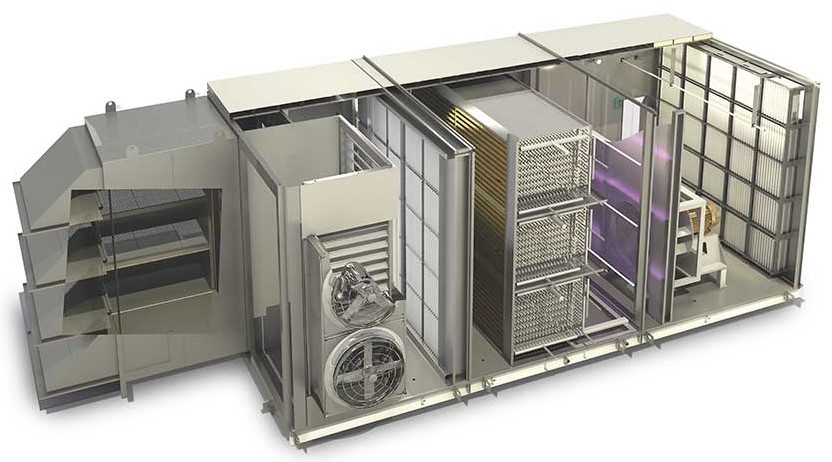The U.S. Food and Drug Administration (FDA) estimates that 48 million people will experience some form of foodborne illness each year. When linked to food processing, these outbreaks can result in costly plant shutdowns and lost revenue. As a preventive measure, the FDA developed the Food Safety Modernization Act (FSMA) detailing safety guidelines referred to as Hazard Analysis and Critical Control Points (HACCP). Although the HACCPs have yielded significant improvements overall, they fall short when it comes to establishing hygienic air standards. Even the most recent FSMA updates offer only broad recommendations on processing room temperature, humidity, and filtration best practices that are lumped into broader preventive control guidelines.
Although the benefits of indoor air quality (IAQ) and building ventilation are well known, methods for managing food processing room airflow have largely remained unchanged for decades. Currently, many facilities rely on ceiling-hung evaporators because of their ability to effectively control temperature and humidity. Although these units are often compliant in meeting the minimum HACCP requirements, they are unable to establish and maintain truly hygienic air that is necessary to ensure sanitary food processing protocols.
A primary setback of ceiling-hung evaporators is their inability to intake or exhaust air. Instead, the units use recirculation to maintain airflow within the process room. In the process, the evaporator also has the potential to recirculate airborne pathogens and microbes, including viruses, bacteria, pollen, and fungi that may be present within the space. These airborne contaminants are often distributed during common processing activities, they drift in from outdoor areas surrounding the building or they migrate from less hygienic zones within the facility. Uncontrolled, transient microbial particles can contaminate open products and colonize in catch points. Effects from unwanted microbes can range from compromised shelf stability and degraded quality and taste in finished food products to IAQ-related occupational risks and widespread disease and illness.

Benefits of hygienic air systems
Effectively managing microbes and airborne contaminants in processing rooms requires more than cold temperatures and recycled air circulation. It requires systematic flow of air exchange, high filtration, positive pressurization, and consistent temperature and humidity control. To achieve this, many facilities are replacing ceiling-mounted evaporators with hygienic air systems.
Hygienic air systems are designed to continuously flush the processing room with highly filtered, fresh air while exhausting stagnant air and humidity. The process yields four key benefits to the processing room environment when compared to standard, ceiling-hung evaporators:
Outdoor air ventilation
A core benefit of a hygienic air system is the ability to ventilate fresh air into the processing room. Outdoor air is drawn into the system, filtered, and then conditioned to control humidity. Advanced systems leverage both economizer and variable-speed drive (VSD) technology to enable the system to adjust airflow strategies depending on the outdoor conditions. For example, in warmer, humid conditions, mechanical cooling may be used to remove moisture from the air stream. In colder, dryer environments, heating may be used to increase the moisture-capturing capacity. And in cool, dry climates, free-cooling can enable the system to rely completely on fresh air in-take to enhance energy efficiency.
Highly filtered airflow
Air passing through the hygienic air system undergoes a stringent, two-phase filtering process to ensure maximum cleanliness. Fresh airflow is immediately filtered to capture airborne particles, then passed through a MERV 14 final filter (upgradeable to MERV 18 HEPA), which is capable of capturing particles as small as one micron.
Additionally, ultraviolet (UV) light can be used to further disinfect the airflow and inhibit microbial growth around the cooling coils.
Positive pressurization
Not all spaces within a food processing facility have the same hygienic requirements. Hygienic air systems create a positively pressurized environment within the processing room to prevent infiltration from less hygienic zones. The fresh air intake present within hygienic air systems enables small quantities of outdoor air to ventilate into the processing room to offset any air removed by processing equipment or escaping the space through doors and openings. Hygienic air systems can help to create a constant air velocity to ensure maximum coverage is obtained and condensation risk is minimized. All AcuAir hygienic air systems are equipped with pressure monitoring capabilities to maintain the correct pressure at all times.
Consistent temperature and humidity
Maintaining correct, uniform temperatures within the food processing space limits the ability of contaminants to activate or propagate, increasing the safe production times between necessary sanitary wash-down periods. Ideally, processing rooms should maintain a consistent temperature of 45 F to 35 F to prevent microbial growth and reduce the frequency of required daily sanitation cycles.
Specialized cleanup settings strategically distribute fresh airflow to air across the room’s ceiling and walls to provide a continuous flow of humidity collection and surface drying before also absorbing airborne moisture to be exhausted outdoors. This allows processing rooms to be ready for production faster.
Optimization through advanced controls
Advanced controls can further enhance processing room performance through automation and comprehensive monitoring. Sensors placed throughout the room and within the hygienic air system automatically monitor and maintain performance standards such as consistent positive room pressure. As the dynamics of the room change, these controls enable the system to auto-adjust based on preset performance standards. These features provide access to insights on-site and remotely via apps or website connections, enabling consistent performance from anywhere during any time of day. Cloud data collection will optimize system operation through machine learning and predictive maintenance.
Future-ready solutions for evolving standards
As airborne disease and food contamination standards continue to change, so will the technologies designed to maintain safe environments. Hygienic air systems are just one way many manufacturers have evolved to better protect product quality and public health against these threats.
Hygienic air systems can optimize indoor air quality in food processing facilities by introducing outside air, continuously filtering it, and maintaining consistent positive pressure, temperatures, and humidity levels. Microbial and pathogen mitigation, energy-efficient free cooling, enhanced IAQ, and reduced downtimes are four key areas that can help to optimize process room performance.
Traditional ceiling-hung evaporators can only solve a portion of today’s food processing room requirements, ultimately posing significant risks to food processing facilities and public safety. When cold temperature isn’t enough to ensure safe food processing, facility managers should consider the dynamic benefits of hygienic air processing systems.
- [i] “What You Need to Know about Foodborne Illnesses,” U.S. Food & Drug Administration (2022) https://www.fda.gov/food/consumers/what-you-need-know-about-foodborne-illnesses
- [ii] “FSMA Final Rule for Preventive Controls for Human Food,” U.S. Food & Drug Administration https://www.fda.gov/food/food-safety-modernization-act-fsma/fsma-final-rule-preventive-controls-human-food




